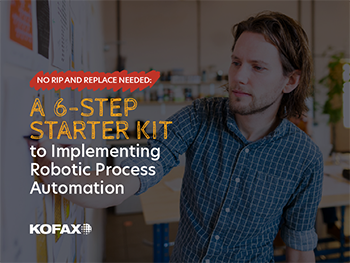4 Hidden Costs Lurking in Your Business
Blog: Kofax - Smart Process automation
Cost analysis is easy, right? Business economists itemize the costs of products or services by breaking them into two buckets, direct and indirect costs. Direct costs include items like labor and materials, while indirect costs include overhead and support. But how can companies measure hidden costs that stem from manual data entry like inefficient operations, poor customer service, failure to comply with regulations or the inability to go to market faster than their competitors?
While these costs are difficult to measure with an accounting yardstick, they are an expensive and growing problem. Let’s take a look at four hidden costs that result from humans performing manual data entry—and how your business can achieve savings and agility with automation.
Hidden Cost: The inefficient and the idle
According to the Cognizant Center for the Future of Work, organizations automate just 25-40% of their workflow. Meanwhile, employees spend 22% of their time on mundane, repetitive tasks.workflow. Meanwhile, employees spend 22% of their time on mundane, repetitive tasks.
While some of your processes are likely automated, many data entry tasks fall through the process automation cracks because your network of internal and external systems—partner, customer and web—is not fully integrated. The challenge is in finding an ideal solution that can seamlessly integrate systems and automate manual front and back office tasks without disrupting either day-to-day business or your legacy systems.
Hidden Cost: The slow and the painful
Whether you’re onboarding a new customer and manually processing data and documents or providing customer service that involves the collection, integration and input of information into a business process, performing these tasks manually reduces customer satisfaction and causes new customers to churn.
In the banking industry, 64 percent of banks report lost deals and revenue due to problems with onboarding. According to McKinsey research, those onboarding problems stem from the fact that more than 70 percent of applications are paper-based, and of those, 30 to 40 percent contain errors and require manual, time-consuming reworking. No wonder a who pping 90 percent of new banking customers abandon their applications before completion.
pping 90 percent of new banking customers abandon their applications before completion.
Hidden Cost: Comply or Else
A new Celent report says compliance costs are exploding due to two factors: running compliance operations and heavy fines due to inadequate controls. Deutsche Bank was recently fined a record £163M for failing to maintain an adequate anti-money laundering (AML) control framework for several years, and they’re not an anomaly.
With humans making ten errors for every 100 steps of a manual process, the stage is set for regulatory non-compliance.
Hidden Cost: Slow delivery
At the 2016 Davos World Economic Forum, Salesforce.com CEO Marc Benioff said, “Speed is the new currency of business.”
When your “currency” is slow because humans performing manual labor only work eight hours a day, need lunch breaks and vacations, and sometimes make mistakes that create other hidden costs like compliance and customer service issues, you simply can’t keep up with competition that’s streamlined and automated operations.
Not only does process automation improve efficiency and reduce costs so you can go to market with better solutions, but automation elevates employees to perform higher-level knowledge work that will move the company forward even faster.
Dump the hidden costs of bad customer service, manual data entry, compliance issues and falling behind the competition
Despite the steep hidden costs of manual data entry labor, automating these tasks is often a low priority for overburdened IT teams that can’t get to all of the project requests. You likely have a business process management or case management platform that automates a majority of processes, but it’s the long tail—the final mile in the marathon of automation—that creates those hidden costs and can be so difficult to execute.
How can your organization drive efficiencies without a big IT intervention and a month or even multi-year long implementation project that disrupts day-to-day business? Robotic Process Automation (RPA) software integrates with, rather than replaces, your existing technology, so it’s both complementary to core systems and non-disruptive to daily work.
Instead of relying on complex integration and process re-engineering, RPA uses intelligent software robots to mimic human actions while applying sophisticated business rules along the way. These software robots can do all the manual and mundane tasks like copying and pasting data between your systems of record, emails, databases, public websites, web portals and more…with 100 percent accuracy you simply can’t attain manually.
Learn how forward-thinking companies take a holistic approach to process automation that includes human workers, software robots and business process management and case management automation software.Download human workers, software robots and business process management and case management automation software.Download No Rip and Replace Needed: A 6 Step Starter Kit to Implementing Robotic Process Automation today.
Comments (1)
Leave a Comment
You must be logged in to post a comment.








Also, some software are automating even more of processes. Some capture software can even find and accurately extract much more text than a couple of years ago. My team just started using this tool and it has let one person totally devote her time to higher-level tasks, like data analysis.